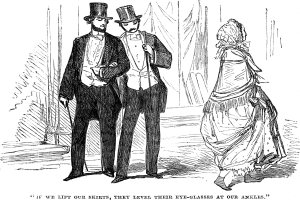Sexual freedoms of long ago tamed by modern times
02 Mar 2011
A study by a University of Manchester historian has cast doubt on the widespread belief that the Victorians and Edwardians were prudes who had few sexual freedoms.

It was advent of the private bedroom, modern suburb and social housing, says Dr Lief Jerram, which tamed a ‘free-for-all’, widespread in many Western cities before the First World War.
A benign tolerance of gays by the police and courts in the 1900s – with a few notorious exceptions – he argues, gave way to a ‘reign of terror’ in the 1950s and 60s, when thousands of people were imprisoned and persecuted – especially in the UK.
“Because the vast majority of people lived and slept together in overcrowded rooms before the First World War, lacking privacy, the street was the place to go have sex,” said Dr Jerram.
Newly established public amenities of a century ago, such as baths and toilets, provided the opportunity for amorous encounters he writes in “Streetlife” published this month by Oxford University Press.
The book pulls together cutting-edge research from across Europe, for the first time, to challenge received wisdom on urban life.
London County Council built sports halls and boxing clubs and organised open ponds and swimming areas, banning clothes and excluding women.
And new urban transport technologies provided the ideal forum for gay and straight ‘cruising’ before the Great War.
Same sex relationships were so run-of-the-mill, he adds, that people didn’t think of themselves as gay or straight. In fact to many, homosexuality was profoundly modern and new in the 1900s.
The historian, based in the School of Arts Histories and Cultures argues homosexuality stands for a yardstick for sexuality in general.
He said: “Evidence from most large European cities, from the 1880s to as late as the 1950s, shows that sexual freedom was widespread: for example, many men - even including the military - were relaxed about having sex with other men.
“A range of sources, including pamphlets and middle-class diaries, showed it was commonplace to have encounters with other men outside the bedroom.
“Economist John Meynard Keynes, diplomat Roger Casement and American author, Edward Prime-Stevenson all wrote about their liaisons.”
However, the growth of suburbia and the right to acquire social housing helped change people’s sexual practice, says Dr Jerram.
Young men were geographically removed from downtown areas, where sexual adventure was easier and social life became more segregated from workplaces.
The world of work tended to involve fewer street based transitory jobs: errand boys, telegraph boys, and street porters virtually disappeared.
And the system, he finds, now worked as a package: stay in school during the period of sexual awakening, sign up as heterosexual and you will be transported out of city centres to the suburbs.
Though the Wolfenden committee on homosexuality produced a set of reforms leading to legalisation in 1967, gay love became hidden: hand holding, kissing were all prohibited in public.
He added: “From the 50’s, for the first time children of different sexes and their parents all slept in different bedrooms. Sex was increasingly happening behind closed doors.
“This is also true of the gay world: the rising number rise of gay zones meant a chance encounter was hugely less likely.
“The freedom to the city had been won but at a cost of homogeonization and the enforcement of strict hierarchies within gay culture just as repressive for those on the wrong end of them.”
